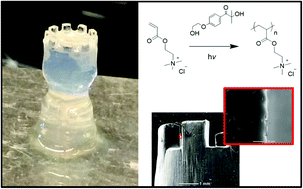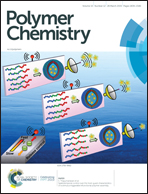Vat photopolymerization of charged monomers: 3D printing with supramolecular interactions†
Abstract
Additive manufacturing enables the creation of novel structures and geometries previously unattainable through traditional processing techniques. In particular, vat photopolymerization provides unprecedented resolution through the tailored delivery of light with photo-crosslinkable or photo-polymerizable materials. Traditionally, chemical crosslinks generate a permanent network, which exhibits swelling but not dissolution. In this work, photopolymerization of photo-reactive monomers with acrylate, acrylamide, and vinyl polymerizable sites enabled the formation of water-soluble 3D printed parts using vat photopolymerization. A library of monomers with varied ionic and hydrogen bonding sites provided photopolymerized films with tensile properties approaching 1200% elongation at break and 0.47 MPa stress at 100% elongation. The rate of polymerization and the subsequent mechanical properties revealed a dependence on the type of supramolecular interactions and functionality on the resulting hydrogel. The diverse functionality of the monomers enabled aqueous dissolution times ranging from 27 to 41 min. Vat photopolymerization of a trimethylammonium ethyl acrylate chloride solution and with 30 wt% N-vinyl pyrrolidone provided 3D parts with fine structural resolution. This method of creating soluble, water-swollen structures through vat photopolymerization provides future research with a larger library of monomers for diverse applications including soluble support scaffolds.

- This article is part of the themed collection: Chemical Advances in Additive Manufacturing


 Please wait while we load your content...
Please wait while we load your content...